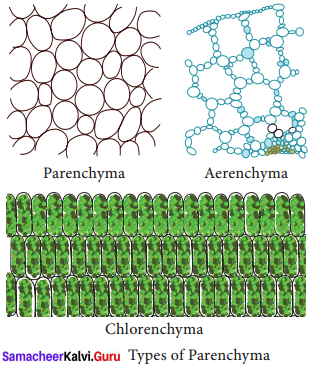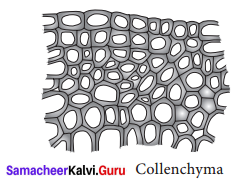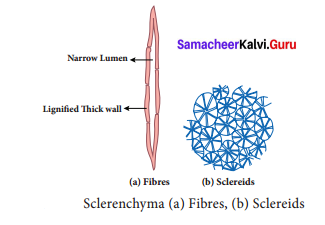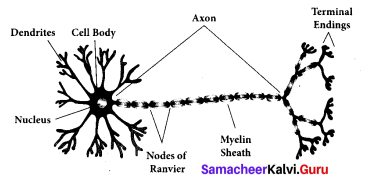You can Download Samacheer Kalvi 9th Science Book Solutions Guide Pdf, Tamilnadu State Board help you to revise the complete Syllabus and score more marks in your examinations.
Tamilnadu Samacheer Kalvi 9th Science Solutions Chapter 18 Organization of Tissues
Samacheer Kalvi 9th Science Organization of Tissues Textbook Exercises
I. Choose the correct answer.
Question 1.
The tissue composed of a living thin-walled polyhedral cell is …………………
(a) Parenchyma
(b) Collenchyma
(c) Sclerenchyma
(d) None of the above
Answer:
(a) Parenchyma
Question 2.
The fibers consists of ……………………
(a) Parenchyma
(b) Sclerenchyma
(c) Collenchyma
(d) None of the above
Answer:
(b) Sclerenchyma
![]()
Question 3.
Companion cells are closely associated with ……………………..
(a) sieve elements
(b) vessel elements
(c) trichomes
(d) guard cells
Answer:
(a) sieve elements
Question 4.
Which of the following is a complex tissue?
(a) parenchyma
(b) collenchyma
(c) xylem
(d) Sclerenchyma
Answer:
(c) xylem
Question 5.
Aerenchyma is found in ………………………
(a) epiphytes
(b) hydrophytes
(c) halophytes
(d) Xerophytes
Answer:
(b) hydrophytes
Question 6.
Smooth muscles occur in ……………………..
(a) uterus
(b) artery
(c) vein
(d) All of the above
Answer:
(a) uterus
Question 7.
Nerve cell does not contain ………………………
(a) axon
(b) nerve endings
(c) tendons
(d) dendrites
Answer:
(c) Tendons
II. Match the Following:
| S. No. | Column A | S. No. | Column B |
| 1. | Sclereids | a | Chlorenchyma |
| 2. | Chloroplast | b | Sclerenchyma |
| 3. | Simple tissue | c | Collenchyma |
| 4. | Companion cell | d | Xylem |
| 5. | Tracheids | e | Phloem |
Answer:
- b. Sclerenchyma
- a. Chlorenchyma
- c. Collenchyma
- e. Phloem
- d. Xylem
III. Fill in the blanks.
- …………… tissues provides mechanical support to organs.
- Parenchyma, collenchyma, Sclerenchyma are …………….. type of tissue.
- ……….. and …………. are complex tissues.
- Epithelial cells with cilia are found in …………….. of our body.
- Lining of small intestine is made up of ………………
Answer:
- Permanent
- simple
- xylem, phloem
- trachea of wind-pipe
- columnar epithelium
IV. State whether True or false. If false, write the correct statement
- Epithelial tissue is protective tissue in animal body – True
- Bone and cartilage are two types of areolar connective tissue – False
Correct statement: Bone and cartilage are two types of supportive connective tissue. - Parenchyma is a simple tissue – True
- Phloem is made up of Tracheids – False
Correct Statement: Phloem is a complex tissue and constitutes: Sieve elements, Companion cells, - Companion cells and Phloem parenchyma.
- Vessels are found in collenchyma – False
Correct Statement: Vessels are found in xylem.
V. Answer briefly:
Question 1.
What are intercalary meristems? How do they differ from other meristems?
Answer:
- It lies between the region of permanent tissues and is part of the primary meristem. It is found either at the base of leaf e.g. pinus or at the base of intemodes e.g. Grasses.
- It differs from apical meristem which is found in apices or growing points and from lateral meristem which are arranged parallel and causes the thickness of the plant part.
- Further apical meristem brings about increase in length and lateral meristem, brings about increase in thickness of the plant. Intercalary meristem helps in production of branches.
![]()
Question 2.
What is complex tissue? Name the various kinds of complex tissues.
Answer:
Complex tissues are made of more than one type of cells that work together as a unit. Complex tissues consist of parenchyma and sclerenchyma cells. Common examples are xylem and phloem.
Question 3.
Mention the most abundant muscular tissue found in our body. State its function.
Answer:
Skeletal muscle is the most abundant muscular tissue found in our body.
Functions:
- These muscles are attached to the bones and are responsible for the body movements and are called skeletal muscles
- They work under our control and are also known as voluntary muscles,
- They possess many nuclei (multinucleate).
- They occur in the biceps and triceps of arms and undergo rapid contraction.
Question 4.
What is skeletal connective tissue? How is it helpful in the functioning of our body?
Answer:
The supporting or skeletal connective tissues form the endoskeleton of the vertebrate body. They support the body, protect various organs and help in locomotion. This system is composed of connective tissues including bone, cartilage, tendons, and ligaments.
Question 5.
Why should gametes be produced by meiosis during sexual reproduction?
Answer:
In meiosis, daughter cells formed after cell division have half the number of chromosomes as compared to parent cell. When gametes are formed by meiosis they will have half the number of chromosomes (haploid). When a haploid male gamete and haploid female gamete fuse during sexual reproduction the zygote will be diploid ie., It will have the same number of chromosomes like the parent cell. This is very important because any abnormality in the number of chromosomes in the zygote will lead to disorders.
![]()
Question 6.
In which stage of mitosis the chromosomes align in an equatorial plate? How?+
Answer:
The chromosomes align in an equatorial plate during metaphase stage of mitosis. Each chromosome gets attached to a spindle fibre by its centromere which is known as the chromosomal fibre. During metaphase the sister chromatids are pulled back and forth until they align along the equator of the cell called equatorial plane.
VI. Answer in detail.
Question 1.
What are the permanent tissues? Describe the different types of simple permanent tissue.
Answer:
Permanent tissues are those in which, growth has stopped either completely or for the time being. At times, they become meristematic partially or wholly. Permanent tissues are of two types namely
- simple tissue and
- complex tissue.
Simple Tissues:
Simple tissue are homogeneous-composed of structurally and functionally similar cells eg., Parenchyma, Collenchyma, and Sclerenchyma.
(i) Parenchyma

Parenchyma are simple permanent tissue composed of living cells. Parenchyma cells are thin-walled, oval, rounded or polygonal in shape with well-developed spaces among them. In aquatic plants. Parenchyma possesses intercellular air spaces and is named as Aerenchyma. When exposed to light, parenchyma cells may develop chloroplasts and are known as Chlorenchyma.
Functions: Parenchyma may store water in many succulent and xerophytic plants. It also serves the functions of storage of food reserves, absorption, buoyancy, secretion etc.
(ii) Collenchyma

Collenchyma is a living tissue found beneath the epidermis.
Cells are elongated with unevenly thickened non-lignified walls.
Cells have rectangular oblique or tapering ends and persistent protoplasts. They possess thick primary non-lignified walls.
Functions: They provide mechanical support for growing organs.
(iii) Sclerenchyma

Sclerenchyma consists of thick-walled cells which are often lignified. Sclerenchyma cells do not possess living protoplasts at maturity.
Sclerenchyma cells are grouped into
- fibres and
- Sclereids.
- Fibres are elongated sclerenchymatous cells, usually with pointed ends. Their walls are lignified. Fibres are abundantly found in many plants. The average length of fibres is 1 to 3 mm, however in plants like Linum usitatissimum (flax), Cannabis sativa (hemp) and Corchorus capsularis (jute), fibres are extensively longer ranging from 20 mm to 550 mm.
- Sclereids are widely distributed in plant body. They are usually broad, may occur in single or in groups. Sclereids are isodiametric, with liginified walls. Pits are prominent and seen along the walls. Lumen is filled with wall materials. Sclereids are also common in fruits and seeds.
Question 2.
Write about the elements of Xylem.
Answer:
Xylem:
(i) Xylem is a conducting tissue that conducts water, mineral nutrients upward from root to leaves.
(ii) Xylem is composed of
- xylem tracheids
- xylem fibres
- xylem vessels and
- xylem parenchyma.
1. Xylem trachelds:
- They are elongated or tube-like dead cells with hard, thick and lignified walls.
- Their ends are tapering, blunt or chisel – like and are devoid of protoplast. They have large lumen without any content.
- Their function is conduction of water and providing mechanical support to the plant. .
2. Xylem fibres
- These cells are elongated, lignified and pointed at both the ends.
- Xylem fibres provide mechanical support to the plant.
3. Xylem vessels
- They are long cylindrical, tube-like structures with lignified walls and wide central lumen.
- These cells are dead as these do not have protoplast.
- They are arranged in longitudinal series in which the partitioned walls (transverse walls) are perforated, and so the entire structure looks-like a water pipe.
- Their main function is transport of water and minerals from root to leaf, and also to provide mechanical strength.
4. Xylem parenchyma
These are living and thin-walled. The main function of xylem parenchyma is to store starch and fatty substances.
![]()
Question 3.
List out the differences between mitosis and meiosis.
Answer:
| Mitosis | Meiosis |
| Occurs in somatic cells | Occurs in reproductive cells |
| Involved in growth and occurs continuously throughout life | Involved in gamete formation only during the reproductively active age |
| Consists of a single division | Consists of two divisions |
| Two diploid daughter cells are formed | Four haploid daughter cells are formed |
| The chromosome number in the daughter cell is similar to the parent cell (2n) | The chromosome number in the daughter cell is just half (n) of the parent cell |
| Identical daughter cells are formed | Daughter cells are not similar to the parent cell and are randomly assorted |
VII. Higher Order Thinking Skills.
Question 1.
What is the consequence that occurs if all blood platelets are removed from the blood?
Answer:
If platelets are absent, this important defense reaction cannot occur, and protracted bleeding from small wounds (prolonged bleeding time) results.
![]()
Question 2.
Which are not true cells in the blood? Why?
Answer:
Platelets are actually not true cells but merely circulating fragments of cells. But even though platelets are merely cell fragments, they contain many structures that are critical to stopping bleeding. They contain proteins on their surface that allow them to stick to breaks in the blood vessel wall and also to stick to each other. They contain granules that can secrete other proteins required for creating a firm plug to seal blood vessel breaks.
Samacheer Kalvi 9th Science Organization of Tissues Additional Questions
I. Short answers questions.
Question 1.
Name the elements present in the phloem.
Answer:
Phloem like xylem is a complex tissue and consists of the following elements.
- Sieve elements
- Companion cells.
- Phloem fibres
- Phloem parenchyma
Question 2.
What is histology?
Answer:
The study of tissues is known as histology.
Question 3.
Describe amitosis.
Answer:
It is the simplest mode of cell division and occurs in unicellular animals, aging cells and in foetal membranes. During amitosis, nucleus elongates first, and a constriction appears in it which deepens and divides the nucleus into two, followed by this cytoplasm divides resulting in the formation of two daughter cells.
![]()
Question 4.
Give reasons why the meristematic cells have a large nucleus and dense cytoplasm.
Answer:
Meristematic cells are continuously dividing cells so they have a prominent nucleus and dense cytoplasm. But since these cells do not store food or waste material, they lack vacuole.
II. Long answers questions.
Question 1.
Give notes on:
- squamous epithelium,
- cuboidal epithelium,
- columnar epithelium,
- ciliated epithelium and
- glandular epithelium.
Answer:
- Squamous Epithelium is made up of thin, flat cells with prominent nuclei. It forms delicate lining of the buccal cavity, alveoli of lungs, proximal tubule of kidneys, blood vessels and covering of the skin and tongue. It protects the body from mechanical injury, drying and invasion of germs. It also helps in filtration by forming a selectively permeable membrane surface.
- Cuboidal Epithelium is composed of single layer of cubical cells. The nucleus is round and lies in the centre. This tissue is present in the thyroid vesicles, salivary glands, sweat glands and exocrine pancreas. It is also found in the intestine and tubular part of the nephron (kidney tubules) as microvilli that increase the absorptive surface area. Their main function is secretion and absorption.
- Columnar Epithelium is composed of a single layer of slender, elongated and pillar like cells. Their nuclei are located at the base. It is found lining the stomach, gall bladder, bile duct, small intestine, colon, oviducts and also forms the mucous membrane. They are mainly involved in secretion and absorption.
- Ciliated Epithelium Certain columnar cells bear numerous delicate hair-like outgrowths called cilia and are called ciliated epithelium. Their function is to move particles or mucus in a specific direction over the epithelium. It is seen in the trachea of wind-pipe, bronchioles of the respiratory tract, kidney tubules and fallopian tubes of oviducts.
- Glandular Epithelium Epithelial cells are often modified to form specialized gland cells that secrete chemical substances at the epithelial surface. Sometimes a portion of the epithelial tissue folds inward to form a multicellular gland, which lines the gastric glands, pancreatic tubules and intestinal glands.
Question 2.
Write a note on the nervous tissue using a diagram.
Answer:

Nervous tissue comprises of the nerve cells or neurons. They are the longest cells of the body. Neurons are the structural and functional units of the nervous tissue. The elongated and slender processes of the neurons are the nerve fibres. Each neuron consists of a cell body or cyton with nucleus and cytoplasm. The dendrons are short and highly branched protoplasmic processes of cyton. The axon is a single, long fibre like process that develops from the cyton and end up with fine terminal branches. They have the ability to receive stimuli from within or outside the body and send signals to different parts of the body. Many nerve fibres are bound together by the connective tissue.
![]()
Question 3.
Describe fluid connective tissue.
Answer:
The blood and the lymph are the fluid connective tissues which link different parts of the body. The cells of the connective tissue are loosely spaced and are embedded in an intercellular matrix.
(a) Blood: contains corpuscles which are red blood cells (erythrocytes), white blood cells (leucocytes) and platelets. In this fluid connective tissue, the blood cells move in a fluid matrix called plasma. The plasma contains inorganic salts and organic substances. It is a main circulating fluid that helps in the transport of substances.
- Red blood corpuscles (Erythrocytes): The red blood corpuscles are oval-shaped, circular, biconcave disc-like and lack nucleus when mature (mammalian RBC). They contain a respiratory pigment called hemoglobin which is involved in the transport of oxygen to tissues.
- White blood corpuscles (Leucocytes): They are larger in size, contain a distinct nucleus and are colorless. They are capable of amoeboid movement and play an important role in body’s defense mechanism. WBC’s are of two types
- Granulocytes (with granules in the cytoplasm): have irregular shaped nuclei and cytoplasmic granules. They include neutrophils, basophils, and eosinophils.
- Agranulocytes (without granules in the cytoplasm): lack cytoplasmic granules and include the lymphocytes which have a spherical nucleus and the monocytes which have a large nucleus indented on one side. They engulf or destroy foreign bodies and neutralize their harmful effects.
- Blood platelets: They are minute, anucleated, fragile fragments of giant bone marrow called megakaryocytes. They play an important role in the blood clotting mechanism.
(b) Lymph: Lymph is a colorless fluid filtered out of the blood capillaries. It consists of plasma and white blood cells. It mainly helps in the exchange of materials between blood and tissue fluids.
![]()
Question 4.
Differentiate between the following:
- Sieve cells and Sieve tubes
- Sclereids and fibres
- Tracheids and vessels
- Sclerenchyma and parenchyma
Answer:
1.
| Sieve cells | Sieve tubes |
| Sieve cells have no companion cells | Sieve tubes always have companion cells |
| Sieve areas do not form sieve plates | Sieve areas are confined to Sieve plates |
| Cells are elongated and are unique long with tapering end walls | Cells consist of vertical cells placed one above the other forming long tubes connected at the walls by sieve pores |
| Sieve pores are smaller and numerous | Sieve pores are larger and fewer in number |
| Sieve cells are found in pteridophytes and gymnosperms | Sieve tubes are found in angiosperms |
2.
| Sclereids | Fibre |
| Usually broad | Elongated narrow thread like |
| End walls blunt | End walls tapering |
| Occur singly | Occur in bundles |
| Deep pit | Narrow pits |
3.
| Tracheids | Vessels |
| Formed from single cells | Made up of number of cells |
| Ends are oblique and taper | Ends are round and transverse |
| Fraction of a cm in length | Several cms in length |
| Walls are thick, lumen-narrow | Walls are less thick, lumen- wide |
4.
| Sclerenchyma | Parenchyma |
| Cells are thick walled and lignified. | Cells are thin-walled and unspecialised. |
| Tissues are made up of dead cells. | These are living cells. |
| No intercellular spaces between the cells are found. | Cells are usually loosely packed with large intercellular space. |
| Provides strength to the plant parts. | Stores nutrients and water in stem and roots. |
| The cells are long and narrow, making the plant hard and stiff. The tissue is present in the stem around vascular bundles in the veins of leaves and the hard covering of seeds and nuts. | Some cells contain chlorophyll called chlorechyma and perform photosynthesis. Other cells have larger air cavities called arenchyma which provide buoyancy to the hydrophytic plants. |